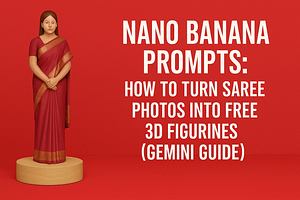D2C trends | Brand innovation | Customer experience branding | How Best D2C Brands Disrupt Branding
Innovative Branding: How the Best D2C Brands Are Setting Trends
Discover how the best D2C brands are revolutionizing branding through authenticity, community, and personalized experiences. Learn trendsetting strategies and actionable insights to build a successful direct-to-consumer business.
Table of Contents
Innovative Branding: How the Best D2C Brands Are Setting Trends
The world of commerce is changing, and at the forefront of this evolution is the Direct-to-Consumer (D2C) model. No longer content with relying solely on intermediaries, brands are taking control, forging direct relationships with their customers, and building empires one personalized interaction at a time. But in a crowded marketplace, simply being D2C isn’t enough. To truly stand out, the best D2C brands are leveraging innovative branding strategies that are not just catching eyes, but setting entirely new trends.
This isn’t your grandfather’s marketing playbook. Forget generic campaigns and mass-market appeals. Today’s successful D2C companies are masters of authenticity, community, and personalized experiences. They’re not just selling products; they’re selling stories, values, and a sense of belonging. Ready to dive into the secrets behind their success? Let’s explore how the best D2C brands are reshaping the branding landscape and how you can learn from their winning strategies.
The D2C Revolution: Why Direct is the New King
Before we delve into innovative branding, let’s quickly understand why the D2C model is booming. It’s more than just a buzzword; it’s a fundamental shift in how businesses operate and connect with consumers. Several factors are fuelling this revolution:
- Technological Empowerment: E-commerce platforms like Shopify, WooCommerce, and social media marketplaces have made it easier than ever for brands to set up shop online and reach customers directly. This technological accessibility levels the playing field, allowing smaller brands to compete with established giants.
- Shifting Consumer Expectations: Today’s consumers crave authenticity, transparency, and personalized experiences. They want to know the story behind the brand, connect with its values, and feel like their individual needs are understood and addressed. D2C brands are uniquely positioned to deliver on these expectations.
- Data-Driven Insights: By owning the customer relationship, D2C brands gain access to a wealth of first-party data. This data is gold. It allows them to understand customer behaviour, preferences, and pain points in granular detail. This, in turn, fuels hyper-personalization, targeted marketing, and product innovation.
- Control Over Brand Narrative: D2C brands have complete control over their brand story and messaging. They can craft a narrative that resonates deeply with their target audience, without the dilution or distortion that can sometimes occur when working through intermediaries.
- Higher Profit Margins: By cutting out the middleman (retailers, distributors), D2C brands often enjoy higher profit margins, allowing them to reinvest in product development, customer experience, and, of course, innovative branding initiatives.
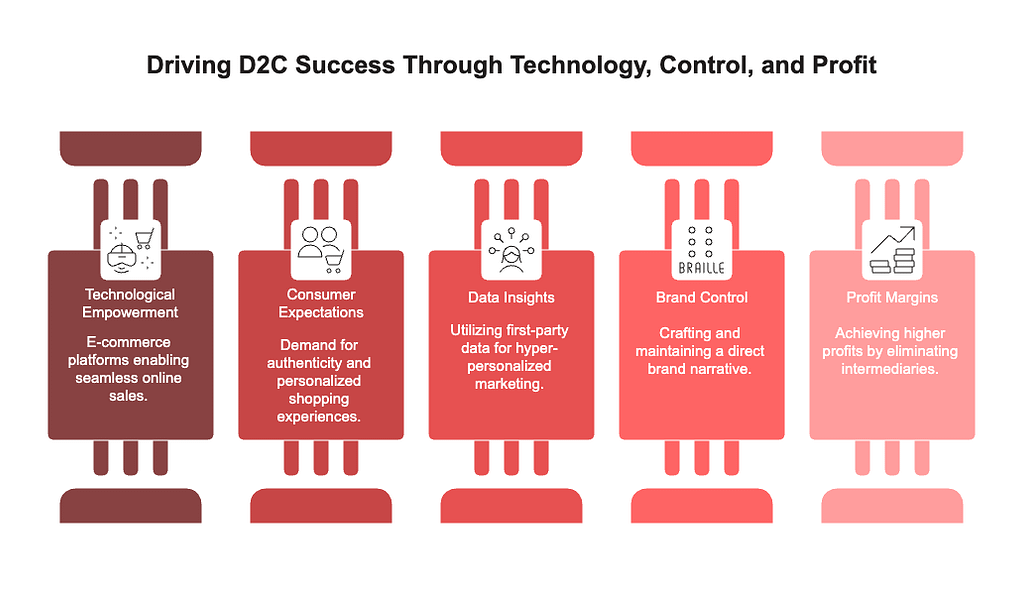
The D2C model isn’t just about selling directly; it’s about building a direct relationship. And that relationship, nurtured through innovative branding, is the key to sustainable success.
Pillars of Innovative D2C Branding: What Sets Trendsetters Apart
So, what exactly are the best D2C brands doing differently? It boils down to a few core pillars that underpin their innovative branding strategies:
1. Authenticity and Transparency: Building Trust in a Skeptical World
In an age of information overload and marketing noise, consumers are increasingly skeptical of traditional advertising. They crave authenticity and transparency. The best D2C brands understand this implicitly and build their branding around genuine values and open communication.
- Real Stories, Real People: Forget stock photos and generic testimonials. D2C trendsetters showcase real customers, real employees, and real stories behind their products. Brands like Everlane, known for its “Radical Transparency,” openly shares its factories, production costs, and ethical sourcing practices. This level of openness builds immense trust and credibility.
- Honest Communication: Transparency extends to communication. The best D2C brands are upfront about their processes, ingredients, and even their mistakes. Ritual, a vitamin brand, is transparent about its ingredient sourcing and scientific backing, building confidence in their product.
- Vulnerability and Humility: Showing vulnerability can be a powerful branding tool. Acknowledging imperfections, admitting mistakes, and being humble humanizes the brand and makes it more relatable. Brands that openly address customer concerns and feedback in a constructive way demonstrate genuine care and build stronger loyalty.
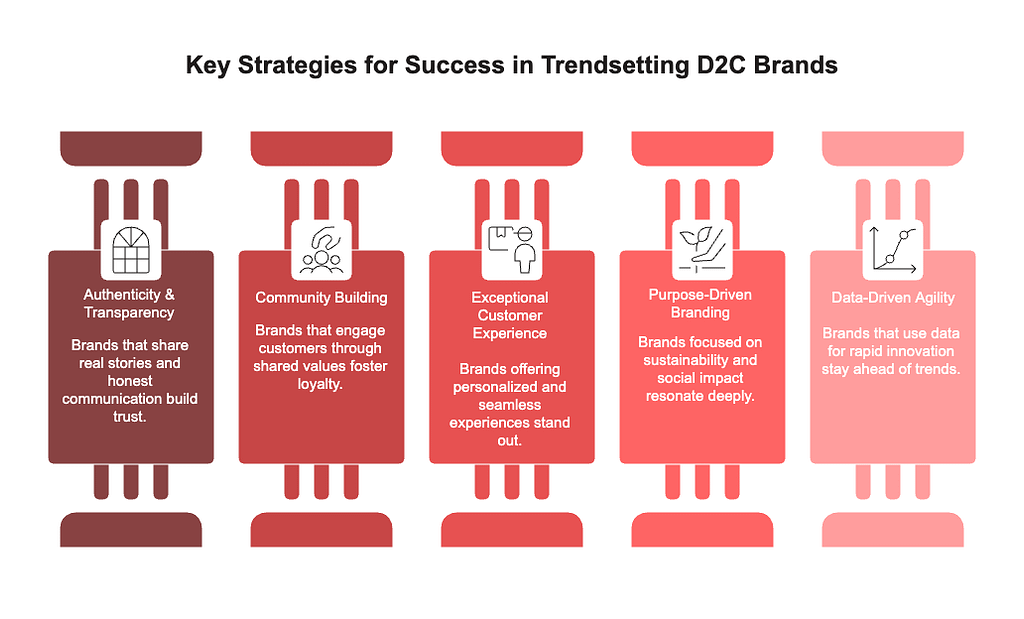
Actionable Insight: Audit your brand messaging. Are you being truly authentic and transparent? Consider sharing behind-the-scenes content, highlighting your ethical practices, and being open about your brand’s journey. Honesty is the best policy, especially in the D2C space.
2. Community Building: Fostering Connection Beyond Transactions
The best D2C brands don’t just see customers as transactions; they see them as members of a community. They understand that building a strong community around their brand creates loyalty, advocacy, and a powerful sense of belonging.
- Shared Values and Purpose: Communities thrive on shared values. Brands that clearly articulate their purpose and connect with customers on a values level build stronger, more engaged communities. Patagonia, for example, has built a massive community around environmental activism and outdoor adventure. Their branding isn’t just about selling apparel; it’s about fostering a movement.
- Interactive Engagement: Community building is a two-way street. The best D2C brands actively engage with their customers through social media, forums, events, and feedback loops. They listen, respond, and create opportunities for customers to connect with each other and the brand. Glossier, the beauty brand, is legendary for its community-driven approach, constantly soliciting feedback and co-creating products with its audience.
- User-Generated Content (UGC): UGC is a powerful tool for community building. Encouraging customers to share their experiences with your products and featuring their content amplifies their voices and makes them feel like active participants in the brand story. Brands like GoPro thrive on UGC, showcasing incredible user-captured footage that fuels their brand narrative and inspires their community.
Actionable Insight: Think beyond transactional marketing. How can you foster a community around your brand? Start by identifying your core values and purpose. Create opportunities for engagement, encourage UGC, and actively participate in conversations with your customers.
3. Exceptional Customer Experience: The Ultimate Differentiator
In a competitive D2C landscape, customer experience is paramount. It’s often the key differentiator that separates the best D2C brands from the rest. It’s not just about good customer service; it’s about creating a seamless, delightful, and memorable experience at every touchpoint.
- Personalization at Scale: Leveraging data to personalize every interaction is crucial. From personalized product recommendations to tailored email campaigns, the best D2C brands make customers feel seen and understood. Function of Beauty, for example, personalizes hair care products based on individual hair types and goals, creating a truly bespoke experience.
- Seamless Omnichannel Experience: While D2C is primarily online, the best brands understand the importance of a seamless omnichannel experience. Whether it’s online, in-store (if they have physical locations), or through customer service channels, the experience should be consistent and effortless. Brands like Warby Parker, starting as online-only, expanded to physical stores to offer a more holistic experience, while maintaining a seamless online-to-offline journey.
- Proactive Customer Service: Excellent customer service is no longer reactive; it’s proactive. The best D2C brands anticipate customer needs and address potential issues before they arise. This might involve proactive shipping updates, helpful FAQs, or even personalized onboarding experiences. Chewy, the online pet supply retailer, is renowned for its exceptional customer service, often going above and beyond to delight customers, creating incredibly strong loyalty.
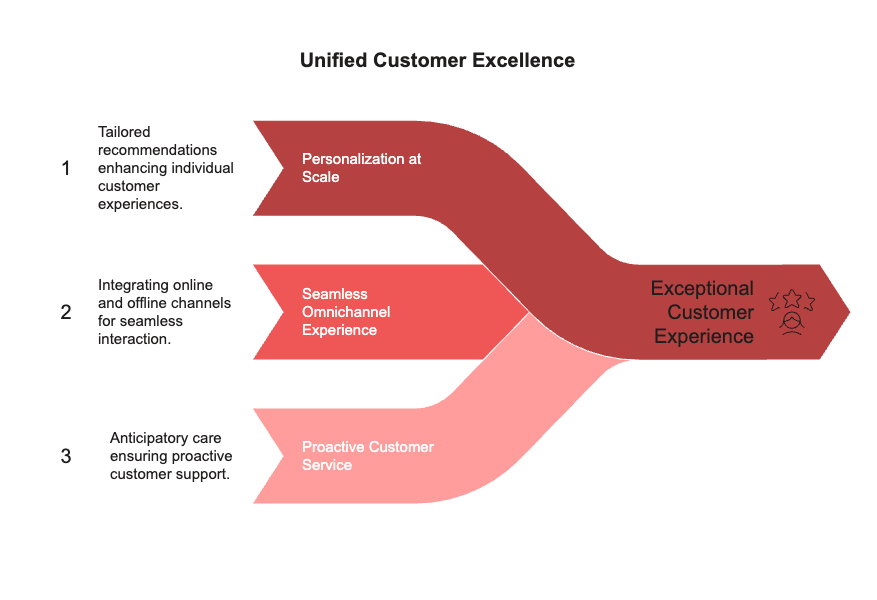
Actionable Insight: Map out your customer journey. Identify friction points and opportunities to enhance the experience at each touchpoint. Invest in personalization technologies and prioritize proactive customer service. Make every interaction a positive one.
4. Purpose-Driven Branding: Appealing to Values and Making a Difference
Consumers are increasingly conscious of the impact of their purchasing decisions. They want to support brands that align with their values and are making a positive contribution to the world. The best D2C brands are often purpose-driven, weaving a social or environmental mission into their brand DNA.
- Beyond Profit: A Mission-Oriented Approach: Purpose-driven brands are about more than just making money. They have a clear mission to address a social or environmental issue. TOMS, famously known for its “One for One” model, built its brand around giving back, donating shoes to children in need for every pair purchased. While the “One for One” model has evolved, their commitment to social impact remains core to their branding.
- Environmental Sustainability: Sustainability is no longer a niche concern; it’s mainstream. The best D2C brands are embracing sustainable practices throughout their supply chain, from ethical sourcing to eco-friendly packaging. Allbirds, the footwear brand, is built around sustainability, using natural and recycled materials and openly communicating its environmental impact.
- Social Impact and Inclusivity: Brands that champion social causes and promote inclusivity are resonating deeply with today’s consumers. This can range from supporting diversity and inclusion initiatives to advocating for social justice. Fenty Beauty, Rihanna’s makeup brand, disrupted the beauty industry by launching with an unprecedented range of shades to cater to diverse skin tones, championing inclusivity and setting a new standard for the industry.
Actionable Insight: Define your brand’s purpose beyond profit. What social or environmental issue are you passionate about? How can you integrate this purpose into your branding and operations? Consumers are drawn to brands that stand for something meaningful.
5. Data-Driven Agility and Innovation: Staying Ahead of the Curve
The D2C model inherently allows for agility and rapid iteration. The best D2C brands leverage data to understand customer behaviour, test new ideas, and adapt quickly to changing market trends. This data-driven agility is a key ingredient in their innovative branding approach.
- A/B Testing and Continuous Optimization: D2C brands have direct access to data on website traffic, conversion rates, customer behaviour, and campaign performance. They use this data to continuously A/B test different branding elements, messaging, and marketing tactics, optimizing for maximum impact.
- Rapid Product Iteration: Direct customer feedback loops allow D2C brands to iterate on products quickly. They can launch new products, gather feedback, and make improvements based on real-world usage and customer preferences. This agile approach allows them to stay ahead of the curve and meet evolving customer needs.
- Personalized Marketing Automation: Data fuels sophisticated marketing automation. The best D2C brands use data to segment their audience, personalize email sequences, trigger automated messages based on behaviour, and create highly targeted and effective marketing campaigns.
Actionable Insight: Embrace a data-driven mindset. Implement analytics tools to track key metrics. Use A/B testing to optimize your branding and marketing efforts. Establish feedback loops to continuously improve your products and customer experience.
Trendsetting Tactics in Action: Real-World Examples of D2C Innovation
Let’s look at some specific examples of how best D2C brands are implementing these innovative branding strategies:
- Warby Parker (Eyewear): Revolutionized the eyewear industry by offering stylish, affordable glasses online. Their innovative branding includes:
- Transparency: Clearly displays pricing and production processes.
- Social Mission: “Buy a Pair, Give a Pair” program (though now evolved to broader vision care initiatives).
- Seamless Online & Offline Experience: Home try-on program and physical stores create a holistic experience.
- Glossier (Beauty): Built a cult following through community-driven branding:
- User-Generated Content: Heavily features customer photos and reviews.
- Social Media First: Built their brand on Instagram, engaging directly with followers.
- Co-creation: Actively solicits feedback and incorporates it into product development.
- Allbirds (Footwear): Pioneering sustainable branding in fashion:
- Eco-Friendly Materials: Uses natural and recycled materials, minimizing environmental impact.
- Transparency: Openly shares their sustainability initiatives and environmental footprint.
- Minimalist Design: Reflects their commitment to simplicity and sustainability.
- Dollar Shave Club (Grooming): Disrupted the razor industry with humor and convenience:
- Humorous and Relatable Content: Viral videos and witty marketing campaigns.
- Subscription Model: Convenient and personalized subscription service.
- Focus on Value: High-quality products at affordable prices.
- Away (Luggage): Reimagined travel luggage with a focus on design and experience:
- Minimalist Aesthetics: Sleek and functional designs.
- Storytelling: Content marketing focusing on travel and experiences.
- Lifetime Warranty: Builds trust and confidence in product quality.
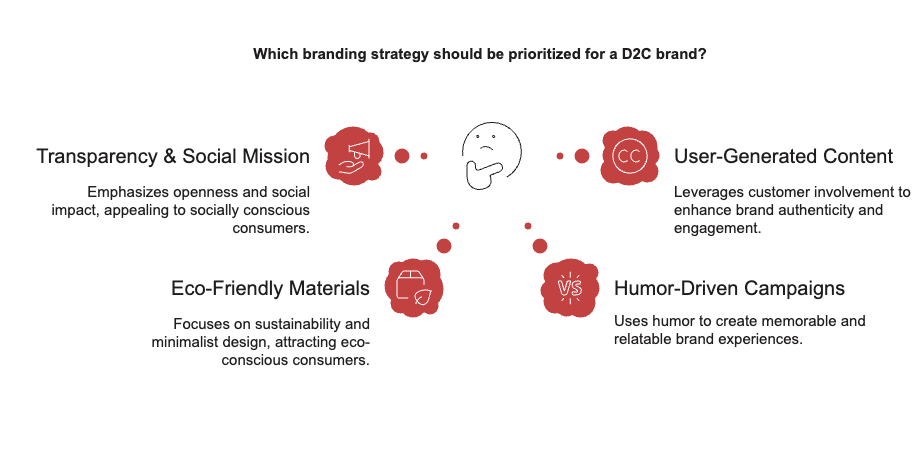
These brands, and many others, demonstrate that innovative D2C branding is about more than just marketing; it’s about building a brand that resonates deeply with customers, fosters community, and creates lasting value.
Actionable Insights for Your D2C Brand: Start Setting Trends Today
Inspired by the best D2C brands? Here are some actionable steps you can take to elevate your own branding:
- Define Your Brand Purpose: What does your brand stand for beyond profit? Identify your core values and mission.
- Embrace Transparency and Authenticity: Be open and honest in your communication. Share your story, your processes, and your values.
- Prioritize Customer Experience: Map out your customer journey and identify opportunities to enhance every touchpoint.
- Build a Community: Create opportunities for engagement and connection with your customers. Foster a sense of belonging.
- Leverage Data for Personalization: Use data to understand your customers and personalize their experiences.
- Experiment and Iterate: Be agile and data-driven. Continuously test and optimize your branding and marketing efforts.
- Focus on Long-Term Relationships: D2C is about building lasting relationships, not just one-off transactions.
Actionable Steps for D2C Branding Success
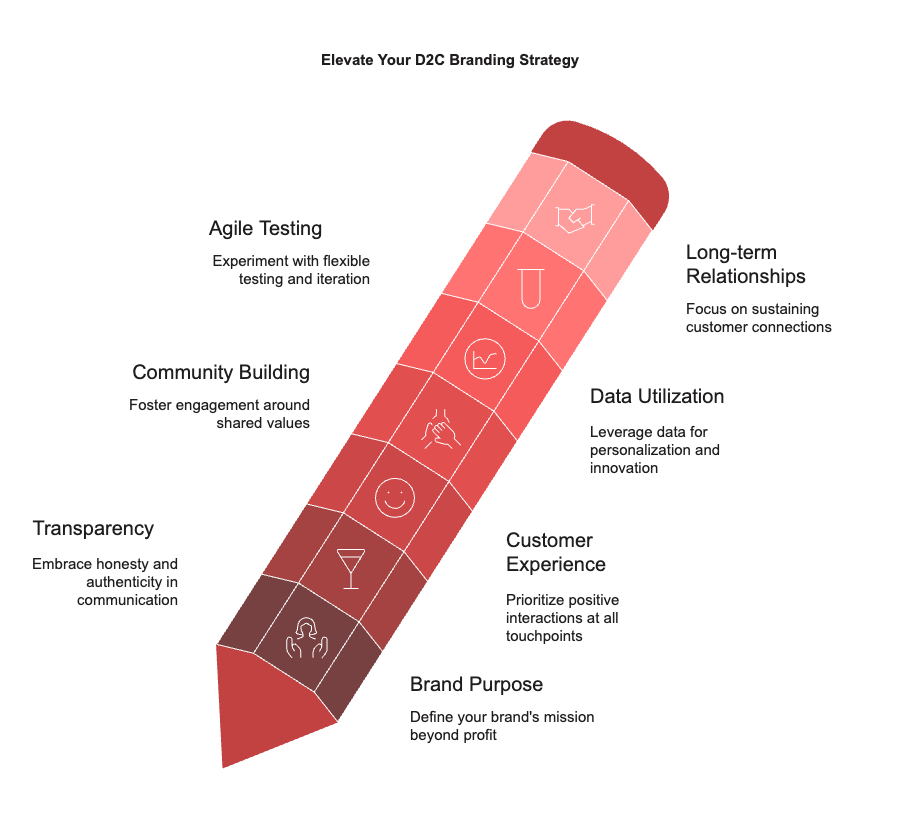
By embracing these principles, you can move beyond just being a D2C brand and become a best D2C brand, setting trends and building a loyal customer base that champions your success.
Your Turn: Let’s Discuss D2C Branding Innovation!
The D2C landscape is constantly evolving, and innovative branding is the key to staying ahead. What are some other best D2C brands you admire for their branding strategies? What innovative tactics have you seen that are truly trendsetting?
Share your thoughts and examples in the comments below! Let’s learn from each other and continue to explore the exciting world of D2C branding. We’re eager to hear your perspectives and insights!
Related Articles
Build a Sustainable D2C Brand: Avoid Greenwashing
10 Proven Tactics for D2C Product Page Optimization





